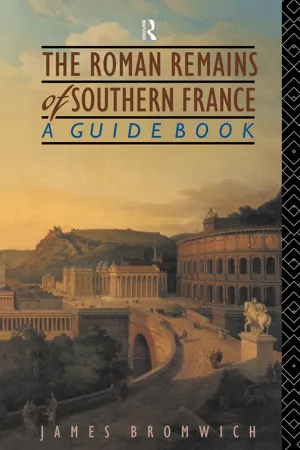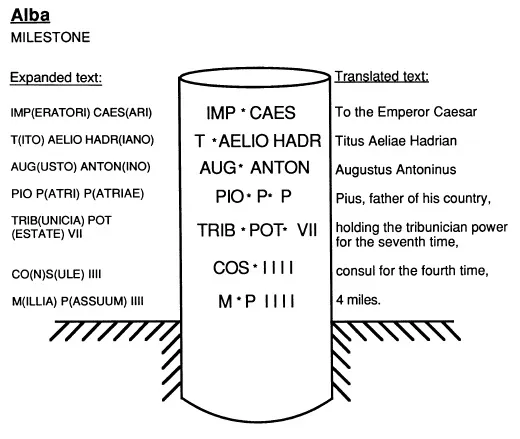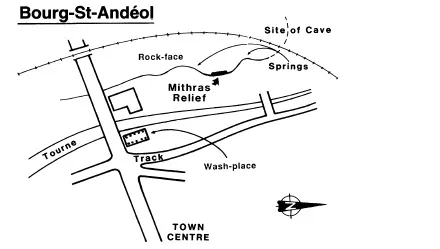
This is a test
- 368 pages
- English
- ePUB (mobile friendly)
- Available on iOS & Android
eBook - ePub
Book details
Book preview
Table of contents
Citations
About This Book
The Roman Remains of Southern France is the only specialist guidebook to this region available. It is the result of the most up-to-date research. Comprehensive in coverage, it provides depth and context while evoking the distinctive atmosphere of the place.
The book is easy to use, with a large number of maps, site plans and photographs and it will enable the traveller to explore the major cultural contribution made by the Romans to this part of France.
Frequently asked questions
At the moment all of our mobile-responsive ePub books are available to download via the app. Most of our PDFs are also available to download and we're working on making the final remaining ones downloadable now. Learn more here.
Both plans give you full access to the library and all of Perlego’s features. The only differences are the price and subscription period: With the annual plan you’ll save around 30% compared to 12 months on the monthly plan.
We are an online textbook subscription service, where you can get access to an entire online library for less than the price of a single book per month. With over 1 million books across 1000+ topics, we’ve got you covered! Learn more here.
Look out for the read-aloud symbol on your next book to see if you can listen to it. The read-aloud tool reads text aloud for you, highlighting the text as it is being read. You can pause it, speed it up and slow it down. Learn more here.
Yes, you can access The Roman Remains of Southern France by James Bromwich in PDF and/or ePUB format, as well as other popular books in History & Ancient History. We have over one million books available in our catalogue for you to explore.
1
THE SITES OF THE LOWER RHONE
ALBA, Ardèche
Michelin 80–9
IGN 59-A8
2,52/49,50gr
4°36/44°34
IGN 59-A8
2,52/49,50gr
4°36/44°34
Town site.
The remains are on both sides of the D107, Viviers to Aubenas road, 1 km north of Alba village.
Gentle bare hills, whose peaks form a rim round a rich agricultural basin, are the sedimentary and volcanic backdrop to the decline of the former chief city of the Helvii people. The small village of Aps, renamed Alba in 1903, is to all appearances a medieval village of tiny streets and gritty limestone and basalt houses with a market, restaurants and a good local information office.
Little is known about the Helvii before the Roman conquest. The isolated exploration of the lower levels shows that the Alba area was occupied in the second century bc but that urbanisation only took place after Caesar's conquest of the rest of Gaul and the introduction of the vine during the first century ad was probably the key to the city's economic growth in the early Empire. The prosperity, though, was shortlived: Alba, outside the main lines of communication, never recovered from the collapse experienced throughout the lower Rhone in the later third century. The replanting of vineyards has inspired the present professional archaeological activity as it has revealed, and threatens to destroy, the extensive ruins just below the surface. Sadly for the visitor, more could be done to keep the exposed remains clear of undergrowth.
The main north-south road
A 10–15 m stretch of the main cardo has been excavated on the northern side of a cutting for the D107. The easiest approach is to walk up the track

Figure 4
50 m to the west. A wall marks the eastern side and a pavement the western.
The Le Palais/‘forum’ site
The cardo runs on through fields and vineyards. It has been recently suggested that the porticoed buildings still hidden here could include the forum. The next exposed section is reached by walking c. 150 m from the modern road in a north-north-west direction, roughly parallel to the cardo. It is partially surrounded by bushes, trees and fencing but is still accessible. This is the site that has traditionally been known as ‘Le Palais’.
The buildings excavated here are now interpreted as a temple complex with five shops facing the road, probably selling gifts for visiting worshippers. The precinct portico was surrounded by a wall with exedras and rectangular recesses.
The theatre
This is the only properly consolidated site in Alba and is signposted from the D107.
It is a curious and rather disappointing place. It still seems dilapidated even after considerable restoration. Despite its discovery in 1821, the three-stage development of the theatre was only finally determined in the early 1980s. Originally an Augustan polygonal cavea was built with wooden seats using the natural sides of a valley, expanded during ad 30–45 and then massively strengthened in the later second century. This final modification gave it a semi-circular shape, a new upper section constructed over vomitoria and a balcony whose vaulted base is still visible. The real surprise is that the river has not changed course but seems to have been present in Antiquity, passing under thepulpituml It was the abandonment of maintenance that led to its destructive role (see model in the museum).
Delauzun site
Almost entirely hidden by grass are traces of two houses and a road.
St Pierre site
At the junction of the D107 and the side road to Alba village, an unidentified Gallo-Roman building, indicated by the petit appareil walling, was found under the remains of two early Christian churches. The remains still confuse professional archaeologists.
The museum
Rue de Chabrol.
Hours: Monday-Saturday 2.00–6.00 p.m.
Hours: Monday-Saturday 2.00–6.00 p.m.
An attractive traditional stone house contains the current museum. It is also the excavation centre and there is therefore only limited, though interesting, material on display.
The finest exhibit is the fish mosaic. It is only part of a much larger mosaic, 12 X 8 m, taken from a dining room, judging by the subject matter and position, in the northern domus on the Delauzun site. The line and colouring of the carp and perch are particularly delicate.
There is a model of the theatre and pictorial displays of the latest excavation work. It is to be hoped that space will be found for showing more

Figure 5
of the finds to the public. Especially interesting is an inscription describing a financial endowment for the centonarii, fabri, utricularii and dendrophori of Alba: the cloth merchants, woodworkers, boatmen and woodcutters. Perhaps we have here a patron not just supporting four leading corporations or guilds, but a fire service as they are known to have been grouped together for this purpose in other Roman towns.
Milestone
On the northern side of the N102 in the twisting bends of the Montée des Combes, about 6 km from Roman Alba down the Frayol valley towards Le Teil.
This well preserved milestone dating from the second century is one of more than twenty that survived on the road up from Nîmes to Alba and down to the Rhone at Le Teil, finishing near Le Pouzin. They represent the town at its most prosperous when it could attract travellers away from the direct north-south Rhone route. The engraver has cut deep into the hard

Figure 6
limestone; his inscription records that it is 4 Roman miles from Alba and was put up in ad 145, using the fourth consulship of Antoninus Pius to give the year. The apparently inaccurate holding of the tribunician power (‘trib.-pot.’ on the milestone) — it should be VIII not VII — occurs on some others as well. Perhaps no one noticed the engraver's inaccuracy before his batch went out to the road.
BOURG-SAINT-ANDEOL, Ardèche
Michelin 80–10
IGN 59-B8/9
2,55/49,30gr
4°38/44°23
IGN 59-B8/9
2,55/49,30gr
4°38/44°23
Mithras bas-relief.
In the town, signposted from centre ville (Place de Mars); about 200 m via Boulevard Jean Jaurès and Avenue de Tourne.
Over 500 Mithraic bull-slaying scenes have been found throughout the Roman Empire; the example at Bourg-St-Andeol is the only one in France to be carved in a rock face. The bas-relief is set in a small, enclosed valley through which the brook, created by two springs, wanders round the back of the town to the Rhone. The railway viaduct has destroyed the cave that lay next to the springs.
An old communal wash-house, the gentle water, the little footbridge, the silence, make it an attractive place for children to play. That they have done so in the past is suggested by the bas-relief itself: it is damaged not just by weather but by stone throwing. Despite this it is well worth visiting, both for what can still be made out and to help understand the context of a Roman mystery religion.
The bas-relief
Now about 2.3 m above ground level, it is thought considerable clearing has artificially raised it. A niche roughly 2 m X 2 m was cut deeply into the sloping rock. Above there was once some sort of facade, however, no detail is recognisable.
Although the relief is cut between the springs, recalling the miraculous birth of Mithras from such a rock, the scene portrayed is Mithras in his classic pose; leaning, knee placed on the bull's back, pulling back its head with his left hand in the animal's nostrils. The left arm is damaged, but less so than the right which has disappeared; undoubtedly this held a sword plunged into the bull's shoulder. The cloak blows out to the left from his shoulders, but his Phrygian hat (conical with a bobble on top) is broken. In the top left-hand corner the sun god Sol has a radiate ‘crown’ of eleven rays, though some observers claim a twelfth. The parallel moon goddess Luna with her crescent crown is much more difficult to make out, top right-hand side. Around the bull are various animals associated with the scene: a dog on the right leaps forward; a snake wriggles along the ground; a scorpion clutches at the bull's genitals. A crater and lion are known on other reliefs and are usually between the bull's bent front legs and the extended right leg of Mithras, a curve carved on the bottom right could be a lion's back. From the bull's tail an ear of wheat grows. Above the cloak, near Mithras' head, but not very clear, is a bird, normally identified as a raven. In the bottom right-hand corner a panel contains an inscription.
Interpreting the bull-slaying scene
The large number of known portrayals and the central position of the scenes in most Mithraic places of worship clearly define it as the crucial image of Mithraism. Unfortunately we are dealing with a mystery cult which kept its secret rites well: its theology is a matter of interpretation and these vary considerably.
Mithras himself and the names of the ranks of the faithful are Iranian and the ‘Mysteries’ arrived in Rome from the east, probably via south-eastern Anatolia. Traditionally, turning to Persian Zoroastrian sources, the scene has been taken to show the climax of the mythical life of Mithras: receiving an order from heaven brought by the raven, he kills the bull. Although unhappy at this destruction he finds that renewed life comes from it, shown by the burst of corn from the tail. The blood-letting symbolises the struggle of good and evil. The scorpion attacks the bull's seed, the snake is fought off by the dog. The snake, together with the crater and lion, form symbols of earth, water and fire, the basic creative elements of the cosmos.
The weaknesses in this explanation are evident in the relief. The snake squirms along the ground; he is not attacking the bull and the dog is nowhere near him. This has led some to see the scene as an embodiment of the continuity of life: as the bull dies his blood is drunk by the dog and both snakes and scorpions were identified with fertility. Mithras is then firmly in the Graeco-Roman tradition of sacrificing a bull.
A recent and totally different approach has stressed the astrological element. All the animals and obviously ...
Table of contents
- Cover
- Half Title
- Full Title
- Copyright
- CONTENTS
- List of figures
- List of plates
- Preface
- INTRODUCTION
- CHRONOLOGY
- 1 THE SITES OF THE LOWER RHONE
- 2 THE SITES OF LANGUEDOC-ROUSSILLON
- 3 THE SITES OF CENTRAL PROVENCE
- 4 THE SITES OF EASTERN PROVENCE
- Glossary
- Select bibliography
- Index